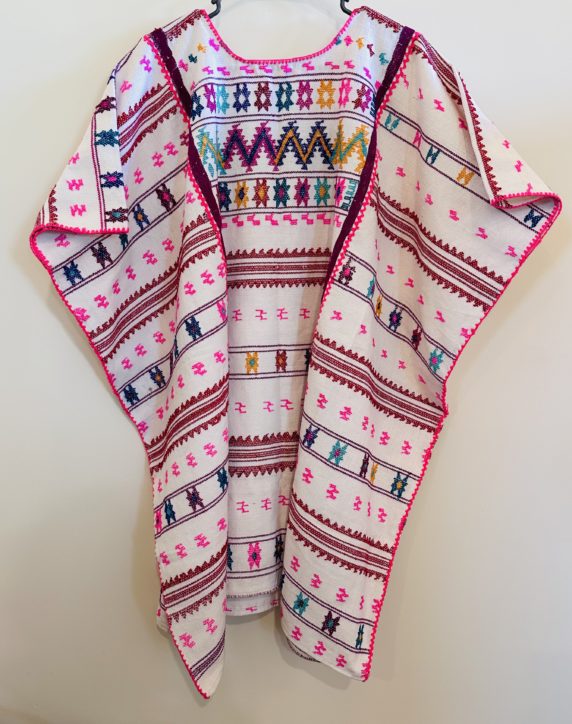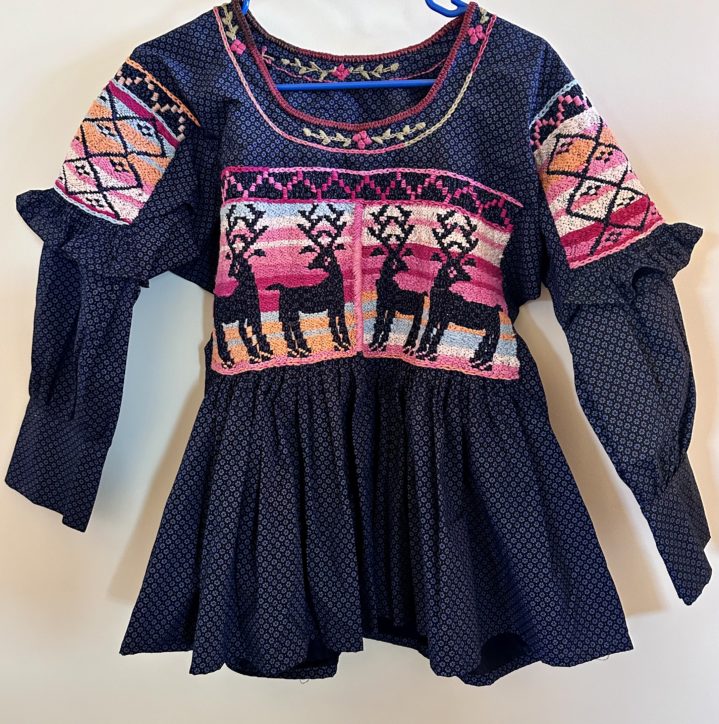Round Two: Oaxaca Textile Marketplace — Handbags and Shoulder Bags
As I prepare to return to Mexico on November 16, I continue to sweep through trunks, storage boxes, closet and drawers to offer for sale pieces I have collected, never worn or used. Perhaps there is a treasure here that would be a perfect addition to your wardrobe or to gift to someone special in the coming holiday months.
How to Purchase? Send an email to me, Norma Schafer. Tell me the piece — by number — that you want to buy. Also include your mailing address. I will send you a link to make a PayPal payment that will include the cost of mailing via USPS Priority Mail. If you are in Canada, it will be sent international First Class.
Item #1A: Traditional Zapotec pouch shoulder bag with cord braided shoulder strap, made by the Mendoza family from Teotitlan del Valle. 100% wool. Tapestry weave. 10″ x 11-1/2″ Shoulder strap is 45″ long where it connects to the bag. $95 USD plus shipping.
Item #1B: Zapotec pouch cotton shoulder bag with flap, woven by the Mendoza Family. Flat weave strap is made on back-strap loom by Abigail Mendoza from Santo Tomas Jalieza. Fine weave. 8-1/4″x 10-1/2″ Shoulder strap is 41″ long from where it connects to the bag. $125 USD plus shipping.
Item #1C: Zapotec pouch wool, cotton and silk shoulder bag with cord braided should strap, made by the Mendoza family. Fine weave. 7-1/4″ x 8″ Shoulder strap is 53″ long from where it connects to the bag. $125 USD plus shipping.
Item #1D: Zapotec pouch shoulder bag with cord braided shoulder strap, made by the Mendoza family. 100% wool. Tapestry weave. 7″ x 8″ Shoulder strap is 53″ long from where it connects to the bag. $95 USD plus shipping.
#2A: Large shoulder bag/tote, all natural dyes, indigo and wild marigold, fully lined with inside pocket and strong zipper closure. Big enough to hold iPad. 11″ x 13-1/2″ with 44″ shoulder strap to where it connects to the bag. Shoulder strap is 1-3/4″ wide and is hand-loomed, too. Hand-stitching details on bag made by Bii Dauu Cooperative. $85 USD.
#2B: Nice Zapotec diamond design shoulder bag in earthy tones of rust, olive and brown, with traditional braided shoulder strap. 9″ x 9-1/2″ Shoulder strap is 41″ long from where it connects to the bag. Fully lined with zipper closure. Made in Teotitlan del Valle. $35 USD plus shipping.
#2C: Very finely woven tapestry shoulder bag by Bii Dauu Cooperative, with high quality adjustable fine grain cowhide black leather strap, brass grommets, and black leather trim . 8″ x 9″ Shoulder strap adjusts to fit 45″ to 56″ long. $115 USD plus shipping.
#2D: Tapestry and leather shoulder bag, 9-1/2″ x 9-1/2″ that is fully lined with zipper closure, 44″ long brown leather shoulder strap secured to bag with brass ring, grommets, and with leather trim. $75 USD plus shipping.
#2E: Whimsical hand embroidered on natural gray sheep wool pocket bag with tie down flap from Chamula, Chiapas. 7″ x 8″ with a 53″ long shoulder strap. $18 plus shipping.



















































Women Weavers in Teotitlan del Valle, Oaxaca: Part One
Recently, I spent the day with a University of Michigan, public policy and economic development researcher, who asked me to introduce her to the Zapotec weaving culture of Teotitlan del Valle. Her expertise is India. Now, she is exploring how India and Mexico intersect and diverge in their support of artisans, particularly weavers.
hand-woven indigo rug with dye prepared by Juana Gutierrez
During our almost 10-hour day, we visited with five weaving families who work in natural dyes, two of whom are official cooperatives, registered with the government. One of these cooperatives, Vida Nueva (New Life), is solely woman-operated. Our time with spokeswoman Pastora Gutierrez enlightened my knowledge about how women came to become weavers in Teotitlan del Valle.
Federico Chavez Sosa at his loom in Teotitlan del Valle
Weaving on the fixed-frame pedal loom is mostly men’s work. The looms are big and heavy. It takes upper body strength to operate them. When the Spanish friars introduced this tapestry loom (along with churro sheep) to New Spain with the conquest, they trained men to use it, just as men traditionally worked this loom in Europe to create textiles for warmth.
Oaxaca tapestry looms turned out blankets, ponchos, sarapes and other articles of functional cloth for insulation used by people and horses.
Started in the early 1940’s, during World War II when men were overseas, the United States Bracero program opened the opportunity for Mexican men to work legally as temporary, seasonal agricultural laborers. From 1948 to 1964, more than 200,000 Mexican worked in U.S. agriculture each year.
Hand-woven tapestries with spinning wheel
Talk to anyone in Teotitlan del Valle and you will meet someone who participated in this program or has a relative who did. I am told the impact on Teotitlan del Valle was huge and saw the exodus of many of its young and middle-age men. They worked in the fields and orchards of America to earn a living to support their families.
Many men didn’t return.
This is when most women learned to weave.
Young women, who always did the cleaning, carding and spinning of sheep wool, learned to dress the loom and weave tapestries. Many began producing sellable textiles by age 11. Mothers, aunts, sisters, nieces and cousins came together to make this a family endeavor until the men returned, much like the sewing bee in small town USA. The making and selling of textiles remained closely within the family group.
Old sarape design, now a floor rug
By the mid-1970’s, Teotitlan del Valle weaving shifted from blankets and clothing to ornamental floor rugs, brought on by the market demand of Santa Fe interior design style. Importers developed relationships with village weavers who became exporters. Many were men who had learned a little English working in the Bracero program and had returned to the family and village infrastructure.
Resources
Book: Zapotec Women by Lynn Stephen, Duke University Press
Like this:
6 Comments
Posted in Cultural Commentary, Mexican Immigration, Teotitlan del Valle, Textiles, Tapestries & Weaving
Tagged bracero, culture, dye, farmworker, history, Mexico, natural, Oaxaca, tapestry, textiles, weaver, weaving, Women